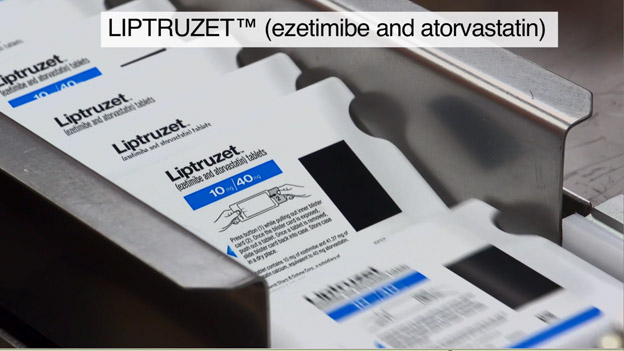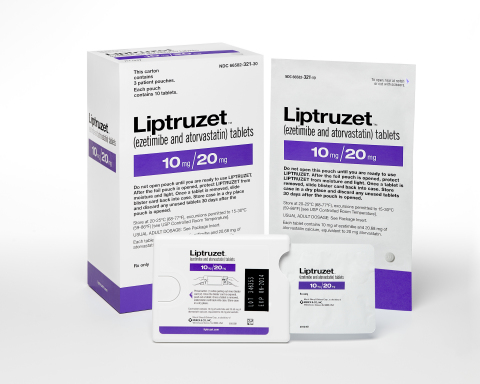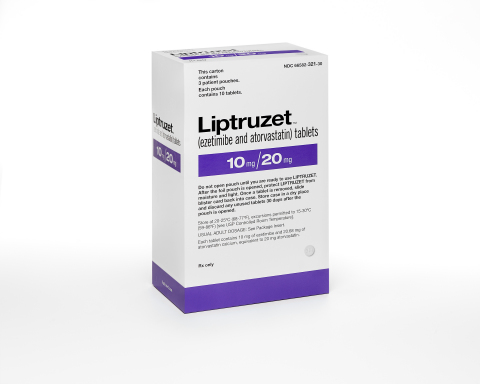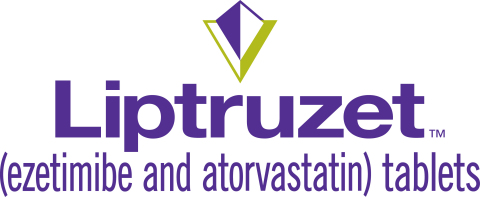WHITEHOUSE STATION, N.J.--(BUSINESS WIRE)--Merck (NYSE:MRK), known as MSD outside the United States and Canada, today announced that the U.S. Food and Drug Administration (FDA) has approved LIPTRUZET™ (ezetimibe and atorvastatin) tablets for the treatment of elevated low-density lipoprotein (LDL) cholesterol in patients with primary or mixed hyperlipidemia as adjunctive therapy to diet when diet alone is not enough. LIPTRUZET (pronounced LIP-true-zett) contains ezetimibe, an efficacious LDL cholesterol lowering therapy, and atorvastatin, currently one of the most widely prescribed statins in the U.S.1 Once-daily LIPTRUZET treats two sources of cholesterol by inhibiting both the absorption of cholesterol in the digestive tract – through ezetimibe – and the production of cholesterol in the liver – through atorvastatin.
No incremental benefit of LIPTRUZET on cardiovascular morbidity and mortality over and above that demonstrated for atorvastatin has been established.
“A significant percentage of patients are unable to lower their LDL cholesterol to recommended levels despite treatment,” said Peter H. Jones, M.D., associate professor of medicine, Baylor College of Medicine. “Along with a healthy diet, LIPTRUZET (ezetimibe and atorvastatin) is an effective new lipid-lowering treatment option that may help address this unmet need as the complementary actions of its components can provide significant additional LDL lowering beyond atorvastatin therapy alone.”
Indications, contraindications, and selected dosage and administration information
LIPTRUZET is indicated as adjunctive therapy to diet for the reduction of elevated total cholesterol, LDL cholesterol, apolipoprotein B, triglycerides and non-high-density lipoprotein cholesterol and to increase high-density lipoprotein (HDL) cholesterol in patients with primary (heterozygous familial and non-familial) hyperlipidemia or mixed hyperlipidemia. LIPTRUZET (ezetimibe and atorvastatin) is also indicated for the reduction of elevated total cholesterol and LDL cholesterol in patients with homozygous familial hypercholesterolemia (HoFH), as an adjunct to other lipid-lowering treatments (e.g., LDL apheresis) or if such treatments are unavailable. No incremental benefit of LIPTRUZET on cardiovascular morbidity and mortality over and above that demonstrated for atorvastatin has been established.
LIPTRUZET is a prescription medicine and should not be taken by anyone who has active liver disease or unexplained persistent elevations in hepatic transaminases or who is hypersensitive to any component of LIPTRUZET. Women who are pregnant, nursing or who may become pregnant should not take LIPTRUZET.
LIPTRUZET is available as a once-daily tablet containing 10 mg of ezetimibe combined with 10, 20, 40, or 80 mg of atorvastatin (LIPTRUZET 10/10, 10/20, 10/40, 10/80 mg, respectively). The dosage range is 10/10 mg/day through 10/80 mg/day.
LIPTRUZET 10/10 and 10/80 mg tablets have been shown to be bioequivalent to coadministration of corresponding doses of ezetimibe and atorvastatin tablets.
LIPTRUZET 10/20 and 10/40 mg tablets have been shown to be clinically equivalent in LDL-C response to the corresponding coadministered doses of ezetimibe and atorvastatin tablets.
The recommended starting dose of LIPTRUZET is 10/10 mg or 10/20 mg taken once-daily, or 10/40 mg once-daily for patients who require a larger reduction in LDL cholesterol (greater than 55 percent). LIPTRUZET can be taken at any time of day, with or without food.
In a clinical study, LIPTRUZET powerfully lowered LDL cholesterol across all doses on average by more than 50 percent (53 to 61 percent, depending on dose)
In a multicenter, double-blind, placebo-controlled clinical study in which 628 patients with hyperlipidemia were treated for up to 12 weeks, LIPTRUZET (co-administered as ezetimibe and atorvastatin) provided LDL cholesterol reductions of 53 percent at the lowest dose (10/10 mg; mean baseline LDL-C 177 mg/dL), 54 percent at the 10/20 mg dose (mean baseline LDL-C 184 mg/dL), 56 percent at the 10/40 mg dose (mean baseline LDL-C 184 mg/dL) and 61 percent at the maximum dose (10/80 mg; mean baseline LDL-C 183 mg/dL). Individualization of drug dosage should be based on therapeutic response.
Pooled across doses, LIPTRUZET reduced LDL cholesterol by a mean 56 percent (mean baseline LDL-C 182 mg/dL) compared with 44 percent for all atorvastatin doses pooled (mean baseline LDL-C 181 mg/dL); p< 0.01. The LDL cholesterol reductions seen by atorvastatin dose were 37 percent at 10 mg (mean baseline LDL-C 185 mg/dL), 42 percent at 20 mg (mean baseline LDL-C 177 mg/dL), 45 percent at 40 mg (mean baseline LDL-C 180 mg/dL) and 54 percent at 80 mg (mean baseline LDL-C 184 mg/dL). The clinical impact of comparative differences in lipid changes between LIPTRUZET (ezetimibe and atorvastatin) and atorvastatin is not known.
In two separate clinical studies, LIPTRUZET 10/40 mg and 10/20 mg provided significantly greater LDL cholesterol reductions and helped more patients get to target LDL cholesterol levels (< 70 mg/dL or < 100 mg/dL) compared to doubling the dose of atorvastatin to 80 mg or 40 mg, respectively
In a six-week study, 556 high risk patients taking atorvastatin 40 mg but not at LDL cholesterol < 70 mg/dL were randomized to either LIPTRUZET 10/40 mg coadministered as ezetimibe and atorvastatin (n = 277; mean baseline LDL-C 89 mg/dL) or atorvastatin 80 mg (n= 279; mean baseline LDL-C 90 mg/dL). Results showed that LIPTRUZET 10/40 mg further lowered LDL cholesterol by an average of 27 percent compared to 11 percent when titrating to atorvastatin 80 mg (p<0.05).This greater additional LDL cholesterol reduction resulted in 74 percent of patients achieving LDL cholesterol <70 mg/dL as compared to 32 percent of patients taking atorvastatin 80 mg.
In a separate six-week study, 184 moderately-high risk patients taking atorvastatin 20 mg but not at LDL cholesterol < 100 mg/dL were randomized to either LIPTRUZET 10/20 mg coadministered as ezetimibe and atorvastatin (n = 92; mean baseline LDL-C 120 mg/dL) or atorvastatin 40 mg (n = 92; mean baseline LDL-C 118 mg/dL). Results showed that LIPTRUZET 10/20 mg further lowered LDL cholesterol by an average of 31 percent compared to 11 percent when titrating to atorvastatin 40 mg (p<0.05). This greater additional LDL cholesterol reduction resulted in 84 percent of patients treated with LIPTRUZET 10/20 mg achieving LDL cholesterol <100 mg/dL as compared to 49 percent of patients taking atorvastatin 40 mg.
Selected cautionary information for LIPTRUZET
LIPTRUZET contains atorvastatin, which occasionally causes myopathy defined as muscle aches or muscle weakness with increases in creatine phosphokinase (CPK) values above 10 times the upper limit of normal. Rare cases of rhabdomyolysis with acute renal failure secondary to myoglobinuria have been reported with atorvastatin and other statins. A history of renal impairment may be a risk factor for the development of rhabdomyolysis. Such patients merit closer monitoring. Other predisposing factors for myopathy include advanced age (≥65 years) and hypothyroidism.
All patients starting therapy with LIPTRUZET should be advised of the risk of myopathy and told to report promptly any unexplained muscle pain, tenderness, or weakness, particularly if accompanied by malaise or fever or if muscle signs or symptoms persist after discontinuing LIPTRUZET (ezetimibe and atorvastatin).Therapy should be discontinued immediately if markedly elevated CPK levels occur or if myopathy is diagnosed or suspected.
The concomitant use of higher doses of atorvastatin with certain drugs such as cyclosporine and strong CYP3A4 inhibitors increases the risk of myopathy/rhabdomyolysis. This includes an increased risk of myopathy when used with fibric acid derivatives, erythromycin, clarithromycin, hepatitis C protease inhibitors, combinations of HIV protease inhibitors, niacin, or azole antifungals. Physicians should carefully weigh the potential benefits and risks of combined therapy with any of these drugs, consider lower doses of LIPTRUZET, and carefully monitor patients for signs and symptoms of myopathy early during therapy and when titrating the dose of either drug.
Avoid LIPTRUZET with cyclosporine, tipranavir plus ritonavir, telaprevir, or gemfibrozil. Use caution when prescribing LIPTRUZET with a fenofibrate, and immediately discontinue both drugs if myopathy if diagnosed or suspected. Cases of myopathy, including rhabdomyolysis, have been reported with atorvastatin coadministered with colchicine, and caution should be used when prescribing LIPTRUZET with colchicine.
The dose of LIPTRUZET should not exceed 10/20 mg daily in patients receiving clarithromycin, itraconazole, saquinavir plus ritonavir, darunavir plus ritonavir, fosamprenavir, or fosamprenavir plus ritonavir, and 10/40 mg daily in patients receiving nelfinavir or boceprevir. Physicians should use caution and the lowest dose necessary with lopinavir plus ritonavir or saquinavir plus ritonavir.
Persistent elevations in hepatic transaminase can occur. Liver enzyme tests should be performed prior to treatment initiation and thereafter when clinically indicated. If serious liver injury with clinical symptoms and/or hyperbilirubinemia or jaundice occurs during treatment, promptly interrupt therapy and do not restart unless an alternate etiology is found.
Increases in HbA1c and fasting serum glucose levels have been reported with statins, including atorvastatin.
In a post-hoc analysis of a study in patients without coronary heart disease who had a stroke or transient ischemic attack within the preceding six months, a higher incidence of hemorrhagic stroke was seen in the atorvastatin 80 mg group compared to placebo. Some baseline characteristics, including hemorrhagic and lacunar stroke on study entry, were associated with a higher incidence of hemorrhagic stroke in the atorvastatin group.
In a clinical trial of LIPTRUZET, the most commonly reported side effects, regardless of cause, included increased alanine transaminase (ALT) (5 percent), increased aspartate transaminase (AST) (4 percent), and musculoskeletal pain (4 percent).
Availability
LIPTRUZET (ezetimibe and atorvastatin) will be available for wholesalers to order the week of May 6.
About Merck
Today's Merck is a global healthcare leader working to help the world be well. Merck is known as MSD outside the United States and Canada. Through our prescription medicines, vaccines, biologic therapies, and consumer care and animal health products, we work with customers and operate in more than 140 countries to deliver innovative health solutions. We also demonstrate our commitment to increasing access to healthcare through far-reaching policies, programs and partnerships. For more information, visit www.merck.com and connect with us on Twitter, Facebook and YouTube.
Forward-Looking Statement
This news release includes “forward-looking statements” within the meaning of the safe harbor provisions of the United States Private Securities Litigation Reform Act of 1995. These statements are based upon the current beliefs and expectations of Merck’s management and are subject to significant risks and uncertainties. If underlying assumptions prove inaccurate or risks or uncertainties materialize, actual results may differ materially from those set forth in the forward-looking statements.
Risks and uncertainties include but are not limited to, general industry conditions and competition; general economic factors, including interest rate and currency exchange rate fluctuations; the impact of pharmaceutical industry regulation and health care legislation in the United States and internationally; global trends toward health care cost containment; technological advances, new products and patents attained by competitors; challenges inherent in new product development, including obtaining regulatory approval; Merck ability to accurately predict future market conditions; manufacturing difficulties or delays; financial instability of international economies and sovereign risk; dependence on the effectiveness of Merck patents and other protections for innovative products; and the exposure to litigation, including patent litigation, and/or regulatory actions.
Merck undertakes no obligation to publicly update any forward-looking statement, whether as a result of new information, future events or otherwise. Additional factors that could cause results to differ materially from those described in the forward-looking statements can be found in Merck’s 2012 Annual Report on Form 10-K and the company’s other filings with the Securities and Exchange Commission (SEC) available at the SEC’s Internet site (www.sec.gov).
Please see accompanying prescribing information for LIPTRUZET™(ezetimibe and atorvastatin) Tablets at http://www.merck.com/product/usa/pi_circulars/l/liptruzet/liptruzet_pi.pdf and patient information for LIPTRUZET™(ezetimibe and atorvastatin) Tablets at http://www.merck.com/product/usa/pi_circulars/l/liptruzet/liptruzet_ppi.pdf.
1 This information is an estimate derived from a custom study of the retail market performed for Merck using IMS Health LifeLink ™ data for the period February 2013. IMS expressly reserves all rights, including rights of copying, distribution and republication.






